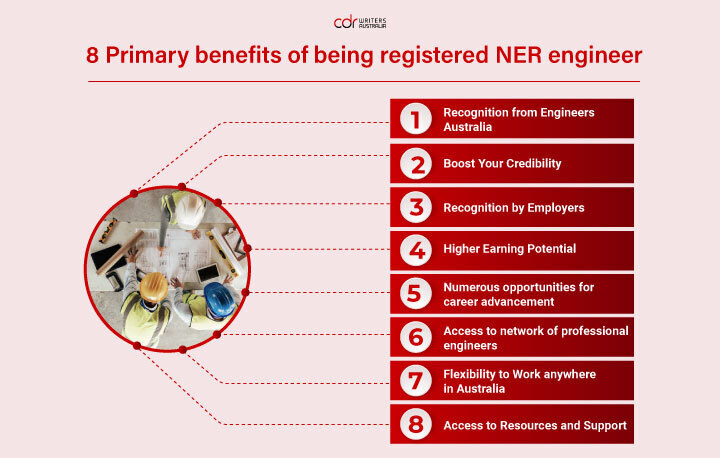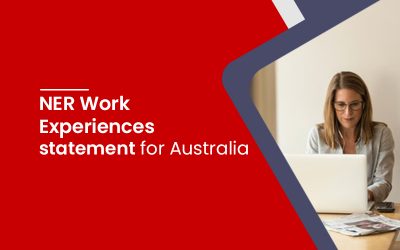8 Advantages of being a Registered NER Engineer

Table of Contents
National Registration Register (NER) is the registration framework introduced by Engineers Australia.
It plays a crucial role in helping engineers gain recognition for their work. Whether starting an engineering career or seeking to grow it, NER takes your career to new heights.
Besides listing qualified engineers; it offers numerous benefits. These advantages aid you as an engineer in consolidating your professional reputation and enhancing your expertise.
So, what are those benefits? Here is our article to answer that query.
What are the advantages of becoming a registered NER engineer?
Here are the primary advantages of being a registered NER engineer:
1. Recognition from Engineers Australia
As soon as you register, you will be honored with the prestigious National Engineering Register post-nominal and digital badges. These honors are given by Australia’s peak engineering body, Engineers Australia.
They are professional appreciation and awards for your distinct engineering competencies and expertise.
2. Boost Your Credibility
Earning post-nominal titles and digital badges brings recognition, esteem, and confidence from the public in your chosen field. Clients and employers will be confident in your skills and ability to deliver safe and reliable engineering services.
3. Recognition by Employers
Think for a second, why would an employer ignore a nationally recognized engineer and opt for others?
Many employers and clients utilize the NER database during the hiring process to mitigate the potential risks of hiring engineers who may be underqualified. Hence, registered engineers attract employers and clients.
4. Higher Earning Potential
NER registration translates to increased earning potential. Employers often provide better pay, perks, and advancement opportunities to attract and keep registered engineers.
5. Numerous opportunities for career advancement
Membership in the NER provides exclusive access to training programs, conferences, and workshops. These opportunities help you: Grow in your engineering field, and Secure leadership roles. This continuous learning positions you for long-term career success.

6. Access to a network of professional engineers
You can engage with a community of professionals who share similar interests or are more experienced in diverse engineering fields. This network offers collaboration, knowledge sharing, and mentorship opportunities.
7. Flexibility to Work anywhere in Australia
Each state and territory in Australia has its own set of employment regulations and conditions. However, NER membership makes it easier to obtain registration in another state and territory. This enables you to pursue opportunities nationwide.
8. Access to Resources and Support
Engineers Australia provides a plethora of resources to assist registered engineers. This includes technical publications, industry updates, Continuing professional development (CPD) opportunities, and mentoring programs. These resources support your ongoing professional growth.
Learn more: National Engineer Registration (NER): Fully Explained. 💪✨
How to join NER?
Joining the NER lets engineers showcase their skills, experience, and background to employers and clients. You don’t need to be a member of Engineers Australia to apply for NER registration.
To qualify for an NER credential, you must satisfy the following conditions:
- To qualify, you need an engineering degree recognized by Engineers Australia or pass their migration skills assessment or membership competency assessment.
- Obtain at least five years of relevant full-time engineering experience within the last decade, including a minimum of four years of postgraduate full-time experience.
- Fulfill all five NER competencies as outlined in the provided document.
List of five NER competencies are:
- Deal with ethical issues: Anticipating consequences means understanding how your actions or decisions affect your team or project and being aware of how they’re managed. It also involves recognizing ethical issues and responding to them appropriately when they arise.
- Practice competently: This entails evaluating, obtaining, and utilizing the skills and resources necessary for engineering tasks.
- Develop safe and sustainable solutions: This entails applying and adhering to up-to-date workplace health and safety standards, recognizing the economic, social, and environmental consequences of engineering endeavors, and effectively anticipating and addressing both short-term and long-term effects of engineering activities.
- Identify, assess, and manage risks: This implies that you establish and function within a hazard and risk framework that is suitable for engineering tasks.
- Local engineering knowledge: This implies acquiring and utilizing engineering expertise specific to the local context. Additionally, it involves applying engineering knowledge sourced from various contributors such as suppliers, consultants, contractors, and independent experts, as deemed suitable.
Here’s how to apply for an NER credential in five steps:
- Sign up on the member portal.
- Log in and fill out the online self-assessment form, where you’ll rate yourself against NER competencies and apply.
- Provide two referees who can confirm your recent work experience.
- Attend an NER interview with an accredited Engineers Australia assessor.
- Receive your application outcome. Successful applicants are added to the NER automatically. If you’re an Engineers Australia member, you can also apply for NER when seeking a Chartered credential.
Required Documents
For members:
- Prepare an expanded CV listing your projects and achievements, including challenges faced and actions taken.
- Highlight instances of innovation and creativity.
For non-members:
- Prepare a detailed CV with project details and achievements, emphasizing problem-solving skills and creativity.
- Include a color-scanned copy of your ID (passport or driver’s license).
- Provide proof of recognized qualifications, like a testamur or transcripts from an accredited program or a membership competency assessment outcome letter.
Referees
- Provide the names and contact information of two referees for your application.
- Referees should ideally be Chartered Engineers Australia members or registered on the NER, or engineers with over five years of post-graduate experience.
- They should have had a recent professional relationship with you and be familiar with your work and experience.
- Referees should work in the same area of engineering as your registration application.
- An assessor will contact each referee to discuss your experience and qualifications.
Fees
Registration on the NER is based on an annual subscription. Different fees apply to members and non-members.
Competency assessment fees:
- Members: $365 (including GST)
- Includes NER registration for the current membership year.
- Renewal fee after the first year: $115 (including GST), invoiced with the annual Engineers Australia membership fee.
- Non-members: $610.50 (including GST)
- Includes NER registration for the current financial year.
- Annual renewal fee after the first year: $185 (including GST).
Key Notes
There are numerous advantages to being a registered engineer in the NER. Rewards include acknowledgment from Engineers Australia and validation from employers, enhancing your trustworthiness and opening pathways for career progression.
Increased income prospects, connection to a community of engineering professionals, eligibility to work in any Australian state or territory, and access to assistance and resources are also benefits.
Read More: Key tips to consider before hiring a NER writer. ⭐✨
FAQs
Who qualifies for NER registration?
Eligibility requires having an engineering qualification recognized by Engineers Australia, a successful migration skills assessment, or a membership competency assessment.
How long does NER registration take?
The processing time varies based on the completeness of your application. Generally, the initial assessment takes around 3-4 weeks.
Is a license necessary for engineers in Australia?
While registration is required in many states, some lack statutory regulations. Engineers intending to work in Australia should verify if state registration is necessary.
How long is the Engineers Australia assessment valid?
The assessment letter remains valid indefinitely with Engineers Australia. Check the Department of Home Affairs for visa application validity.
What PTE score does Engineers Australia accept?
A minimum score of 50 in each of the 4 modules—Listening, Reading, Writing, and Speaking—is required. The test result must be within 2 years of the assessment application.
Recent Posts
- Benefits of RPL Writing for Professional Advancement—Seize the Opportunity! July 8, 2024
- Unlocking Your Potential: Benefits of NER Registration for Engineers—Don’t miss out! July 4, 2024
- 8 Advantages of being a Registered NER Engineer April 25, 2024
- Stage 1 Competency Standard for Professional Engineer December 4, 2023
- Secure Your Future: The Most In Demand Jobs for Skilled Migrants to Australia in 2024 November 3, 2023

